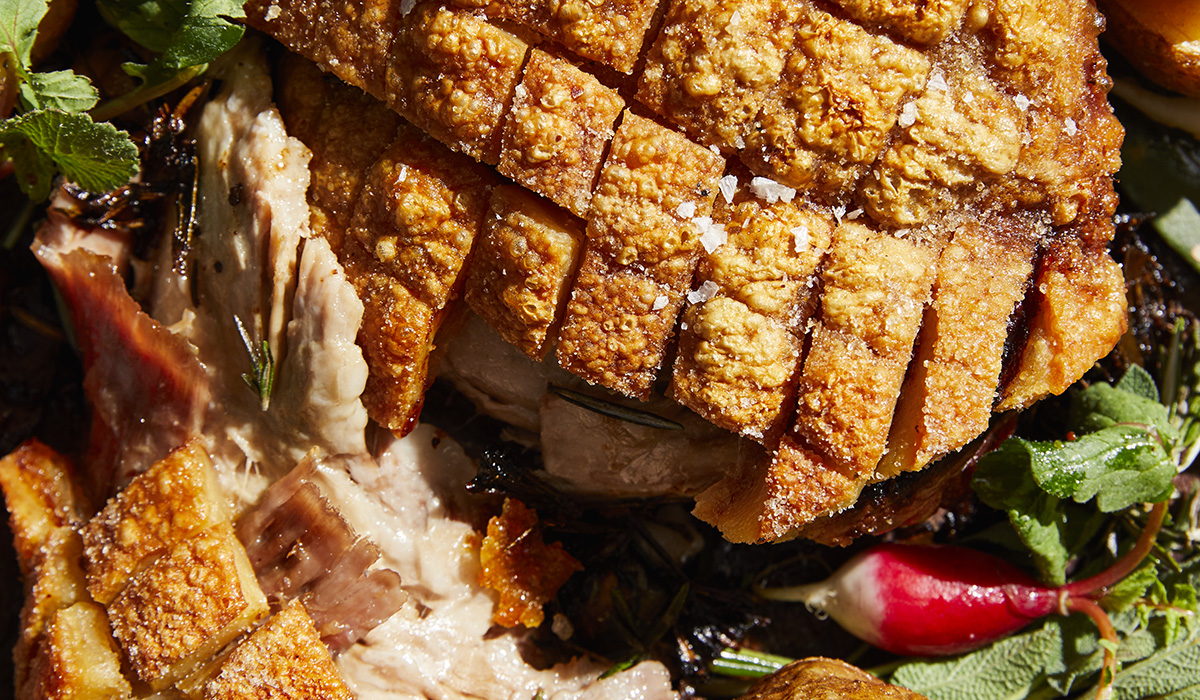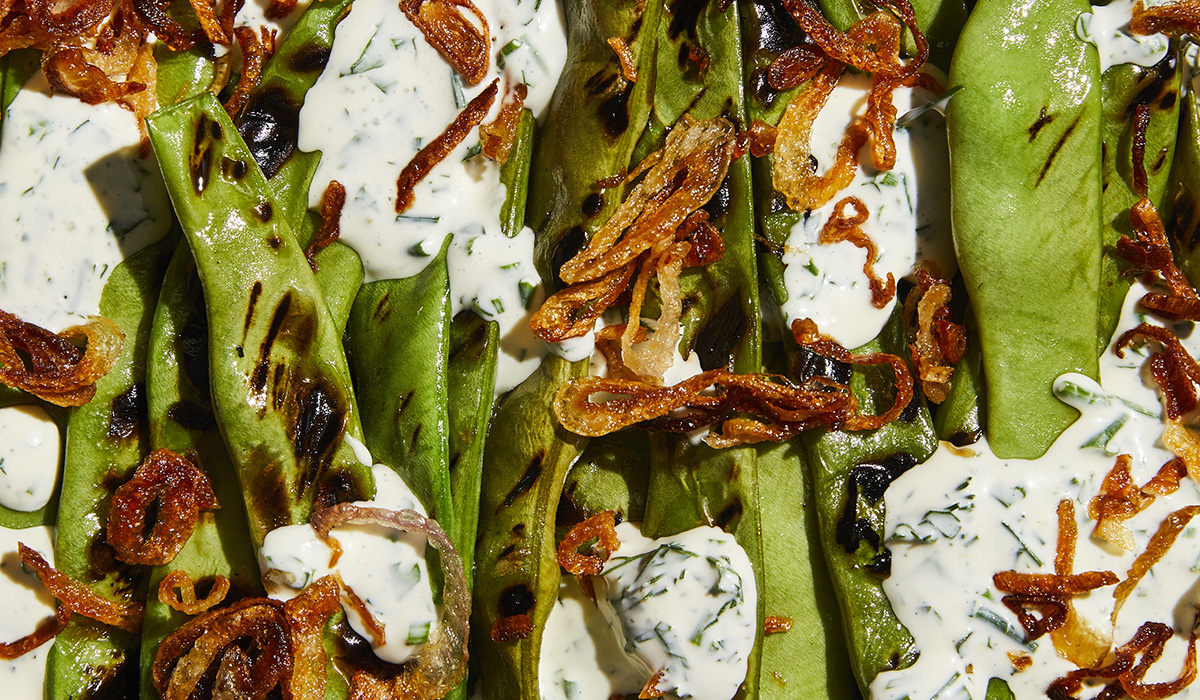
Menu – click to jump to the recipe
1. Porchetta roasted pork shoulder
2. Fig and goat’s curd salad with smoky paprika vinaigrette
3. Charred romano beans with buttermilk herb dressing and crispy shallots
Danielle's wines to match
Danielle points to a range of styles that can work with this meal. Her selections include Western Australian riesling and chardonnay, Italy's Soave from the Veneto and riesling from Alto Aldige, and French Bandol rosé.
Halliday recommends:
Great Southern riesling
Margaret River chardonnay
Adelaide Hills sauvignon blanc
Yarra Valley rosé
Danielle Alvarez is a force. Born to a food-loving Cuban family in Miami, and now based in Sydney, her focus is on farm-to-table cooking, responding to the seasons, and working with a menu that evolves daily. Her debut cookbook Always Add Lemon is a bestseller.
---

Serves 10-12
Ingredients
1 x 5 kg whole pork shoulder, skin on, shank and blade removed
10 dried bay leaves
4 rosemary sprigs
4 thyme sprigs
2 tbsp wild fennel flowers, or 1 tbsp fennel seeds if flowers unavailable
20g garlic, crushed into a paste in the mortar and pestle
Method
Score the skin of the pork in a diamond pattern, then season the skin side liberally with salt. Flip it over and season the flesh side liberally with salt and lots of freshly cracked black pepper.
Crush the bay leaves in your hands and combine with the picked rosemary, thyme and fennel. Spread the garlic liberally all over the flesh side, but not the skin side, then cover the flesh side with all the herbs and fennel and press them in so they stick. Flip it back over so it’s skin-side up and refrigerate, uncovered, for 12–24 hours.
Remove it from the fridge and allow it to come to room temperature for 2 hours. Preheat the oven to 200°C, then roast for 1 hour. Reduce the heat to 150°C and cook for another 5-6 hours. To get crackling skin once the meat is tender and fully cooked, place the pork under the grill of your oven, but don’t walk away from it – it goes from blistered and bubbly to burnt pretty quickly.
---

Serves 4
Ingredients
8 ripe figs
12 large rocket leaves
150 g fresh goat’s curd
70 g toasted almonds
Vinaigrette
20 ml sherry vinegar
20 ml agrodolce-style white-wine vinegar
½ garlic clove
1 ½ tsp pimentón de La Vera dulce
100 ml extra-virgin olive oil
Method
To make your dressing, combine the vinegars in a jar and grate in the garlic.
Add a pinch of salt and the pimentón and shake to combine. Next, add the olive oil and shake again. This can be made ahead of time, but no more than a few hours as the raw garlic tends to change over time and becomes stronger and sweeter.
Tear open your figs at the centre and arrange them on a platter with the rocket and goat’s curd crumbled around. Shake your vinaigrette just before pouring it right over everything. Use only enough to drizzle; you don’t want to drown out the other ingredients.
Finally, scatter your toasted almonds over the top and finish with a good sprinkle of salt. Serve immediately.
---

Serves 4
Ingredients
200 ml grapeseed oil, plus extra for tossing the beans
4 shallots or 1 small red onion, thinly sliced
300-400 g Romano beans
Dressing
150 ml crème fraîche
50 ml buttermilk, plus extra if needed
15 ml lemon juice
1 ½ tsp salt
1 heaped tbsp chopped dill, plus extra fronds to serve
15 g snipped chives
10 g finely minced flat-leaf parsley, plus extra leaves to serve
¼ tsp Worcestershire sauce
Couple of dashes Tabasco sauce
1 small garlic clove
Method
Combine the oil and shallots in a small sauté pan and slowly bring the heat up to medium. The shallots are cooked when they stop sizzling, meaning most of the moisture has cooked out. If they start to colour too quickly, you have heated the oil too fast, so reduce the heat a little. It should take about 8–10 minutes for them to get nice and crispy.
Lift them out of the oil and spread out on paper towel to drain. Season with fine salt and set aside to completely cool. They can be stored in an airtight container until you are ready to use them.
Bring a large saucepan of heavily salted water to the boil. Trim the stem ends of the beans. When the water is boiling, dunk the beans for 2–3 minutes. Test 1–2 minutes: if they’re still crunchy, but soft enough not to feel raw, quickly pull them out of the water and spread them onto a wide tray to steam and cool.
Next, make your dressing. Combine all ingredients except the garlic in a bowl. Use a microplane to finely shave the garlic into the dressing. Lots of black pepper is good here too. Whisk to combine. Add a bit more buttermilk if you want it thinner.
The dressing should be a bit thicker than the consistency of thick cream. Give it a taste and adjust the dressing as needed, then refrigerate until ready to use.
To char your beans, toss them in a small amount of olive oil and set them over a hot grill or in a hot chargrill pan. Cook quickly until they start to caramelise and blacken in a few spots. You don’t want to overdo this; you just want to get that smoky flavour without killing the bean.
To serve, toss your warm or room temperature beans on a platter, drizzle with the dressing and sprinkle over the crispy shallots. Crush a bit more black pepper over the top and garnish with the remaining dill and parsley.
Danielle Alvarez is the head chef at Fred’s, Sydney, and author of Always Add Lemon.
These are summer flavours in my eyes, and exactly the kind of thing I would want to be having at a summer Christmas party.”






